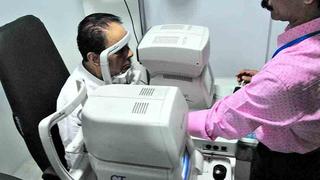
Only 16% of all senior citizens seeking cataract surgery at four LVPEI centres used any insurance, a new study has found.
| Photo Credit: Mohammed Yousuf
India’s population is growing older and eye problems such as cataracts already cause nearly half of all vision‑loss in people over 60. However, fewer than one in eight Indian seniors has any form of health insurance, leaving many to pay on their own or altogether skip care. Recently, researchers from L.V. Prasad Eye Institute checked how often elderly persons actually used insurance when they needed sight‑saving cataract surgery, what kinds of insurance they used, and whether coverage changed the speed and success of treatment.
The team’s findings were published in the August edition of The Lancet Regional Health – Southeast Asia.
The researchers mined an electronic medical record system linking every level of the institute’s network across Andhra Pradesh, Karnataka, Odisha, and Telangana. They pulled all first‑eye cataract operations performed on patients aged 70-100 years between August 2011 and December 2022. They discarded engagements that were charity‑funded and focused on people who had to choose a payment method.
For each of these 38,387 surgeries, they logged gender, age, place of residence, self‑reported socioeconomic class, systemic illnesses, payment mode (out of pocket or insurance), and, if insured, whether the policy was a government scheme or a private plan.
They also recorded the gap between the day surgery was advised and the day it was done. They also graded uncorrected visual acuity three to six weeks after surgery as “good”, “normal” or “poor” following World Health Organisation standards.
Upon analysing the data, the researchers found that insurance was rare and fell off with age. Only 16% of all patients used any insurance. The uptake slid from 17.5% in the 70-74 years band to under 10% after age 85, largely because private insurers stop offering or become too costly. The public schemes were stuck at 3-4% in every age band.
According to the study, after the national launch of the Ayushman Bharat programme and other State schemes ramped up in 2018, overall coverage for cataract surgery jumped to 20.6%, nearly twice the 10.7% in 2011‑2017. According to the team, this policy shift was the single strongest predictor of anyone having insurance.
They also reported that elderly men insured themselves 19% of the time versus only 12% for women. Similarly, people from rural districts were less likely to be covered than residents of metros and that uptake rose steadily with socioeconomic class.
Uninsured patients had surgery a median six days after advice. Those with private insurance waited 11 days and those on government schemes endured an 18‑day median delay, due to the paperwork and approval time. However, after controlling for every other factor, having any insurance made a patient 38% more likely to end up with “good” uncorrected vision. Among people over 80, those without insurance were noticeably more likely to leave surgery till seeing poorly.
In sum, cataract surgery was widely available yet the elders who needed it most often lacked insurance and were more likely to come out with worse eyesight.
“This study is powerful evidence that adequate insurance coverage improves the chances of receiving timely health care while also benefiting from superior outcomes. I would argue that these findings are true not just for cataract surgery, but for all forms of health intervention,” Brijesh Takkar, consultant ophthalmologist at the institute and the first author of the study, said. “Our national health policy should insure the many who are vulnerable to financial insecurity. This has the potential to reduce the burden of healthcare costs on them.”
Published – July 30, 2025 03:50 am IST














Leave a Reply